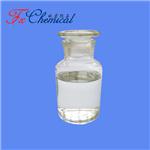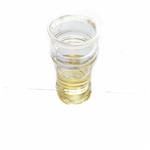Description
1-(3-Dimethylaminopropyl)-3-ethylcarbodiimide is a water-soluble carbodiimide available as hydrochloride salt. This compound is a carboxyl- and amine-reactive crosslinker that is water soluble and can activate carboxyl residues for their reaction with primary amines to form O-acylisourea as a reaction intermediate, which reacts with amide bonds to release isourea as a by-product. It can crosslink the carboxy-group of glutamate and aspartate to the side-chain primary amine of lysine and the amino group at the N-terminus. The crosslinker readily reacts at a pH range of 4.5–7.2 and only crosslinks the residues within their van der Waals distance. 1-(3-Dimethylaminopropyl)-3-ethylcarbodiimide is also widely used in fabricating different nanosystems implemented in drug/protein delivery systems. It is mainly used for surface crosslinking/immobilization of drugs to increase stability against environmental changes, such as pH or temperature[1-2].
Chemical Properties
Clear light yellow liquid
Uses
1-(3-Dimethylaminopropyl)-3-ethylcarbodiimide is used as a carboxyl activating agent and activate phosphate groups in phospho mono and di esters. It is used in peptide synthesis, 3'-amino-3'-deoxyadenosine-5'-di- and triphosphates and in the preparation of antibodies like immunoconjugates. It plays a vital role for immobilization of large biomolecules in association with N-hydroxysuccinimide. It is also used in the acylation of phosphoranes.
General Description
N-(3-Dimethylaminopropyl)-
N′-ethylcarbodiimide is commonly used in combination with
N-hydroxysuccinimide (NHS) in carbodiimide coupling reaction to activate carboxyl group for coupling with amines to form amides.
reaction suitability
reaction type: Coupling Reactions
Synthesis
The production method of 1-(3-dimethylaminopropyl)-3-ethylcarbodiimide is to react with N, N'-dimethylpropanediamine and carbon disulfide as raw materials to prepare N, N'- Dimethylpropylthiourea. Then it is oxidized with ethyl chloroformate to obtain N, N'-dimethylpropyl isothiocyanate, which is then reacted with ethylamine and oxidized with sodium hypochlorite to obtain the product 1-(3-dimethylaminopropyl)-3- Ethylcarbodiimide.

References
[1] Manjula ;Mummadisetti et al.“Chapter Five-An approach to nearest neighbor analysis of pigment-protein complexes using chemical cross-linking in combination with mass spectrometry.” Methods in enzymology" Methods in Enzymology, 680 (2023) 139-162.
[2] Dmour, Isra and M. Taha. “Natural and semisynthetic polymers in pharmaceutical nanotechnology.”Organic Materials as Smart Nanocarriers for Drug Delivery (2018) 35-100.








